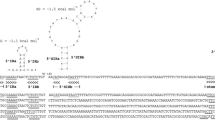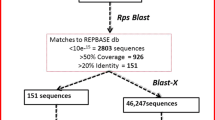Abstract
Most of the transposons so far characterized from mosquito genomes are retroelements which seem to be distributed worldwide. The Juan transposons constitute a family of non-LTR retroelements, or LINE-retroposons, which are dispersed in the genomes of several mosquito species. Three different Juan subfamilies have been characterized, each being amplified in the genomes of many strains, if not all, of a given mosquito species. These subfamilies have been designated respectively Juan-C inCulex pipiens, Juan-Ct inCulex tarsalis and Juan-A inAedes aegypti. A large number of the Juan retroposons which are amplified in the mosquito genomes are apparently full-length copies and potentially encode the enzymes necessary for their transposition, a nucleic acid binding protein and a reverse transcriptase. However, these complete Juan copies seem to be most frequently transcriptionally silent in insects reared under laboratory conditions. A few of them are transcribed inC. pipiens cells grownin vitro, but from an external promoter, the Juan-C specific RNA being fused to an upstream RNA sequence. Therefore, the transcription of Juan retroposons seems to depend on external promoters which are most frequently inactive. The occurrence and distribution of Juan retroposon subfamilies among mosquito species do not reflect the phylogeny of these species. Furthermore, complete Juan-C and Juan-A copies which are reiterated in strains collected from regions covering different continents are nearly identical. Juan-C copies belonging to geographically differentC. pipiens strains display low levels of divergence between their nucleotide sequences and many of the mutations which have occurred among these copies do not alter their coding potential. These results indicate that the Juan retroposons occur as homogeneous subfamilies distributed worldwide and that selective constraints against amino acid change have been acting recently on these elements, despite the fact that they are now highly repeated through mosquito genomes. Therefore, Juan transposons have most probably been recently amplified in mosquito genomes. Each subfamily may have been amplified from one master element present in a unique population which has since spread worldwide. Alternatively, this amplification may have arisen in many mosquito populations, but from highly conserved master elements submitted to selection pressures. Horizontal transfers between species may also have contributed to the spread of these transposons.
Similar content being viewed by others
Abbreviations
- A. :
-
Aedes
- aa:
-
amino acid(s)
- An. :
-
Anopheles
- bp:
-
base pair(s)
- C. :
-
Culex
- D. :
-
Drosophila
- Juan:
-
family of elements reiterated in the genome ofAedes andCulex mosquitoes
- kb:
-
kilobase(s) or 1,000 bp
- LINE:
-
long interspersed repetitive element
- LTR:
-
long terminal repeat
- ORF:
-
open reading frame
- RFLP:
-
restriction fragment length polymorphism
References
Agarwal, M., N. Bensaadi, J.C. Salvado, K. Campbell & C. Mouchès, 1993. Characterization and genetic organization of full-length copies of a LINE retroposon family dispersed in the genome ofCulex pipiens mosquitoes. Insect Biochem. Molec. Biol. 23: 621–629.
Besansky, N.J., 1990a. A retrotransposable element from the mosquitoAnopheles gambiae. Mol. Cell. Biol. 10: 863–871.
Besansky, N.J., 1990b. Evolution of the T1 retroposon family in theAnopheles gambiae complex. Mol. Biol. Evol. 7: 229–246.
Besansky, N.J., V. Finnerty & F.H. Collins, 1992a. Molecular perspectives on the genetics of mosquitoes. Advances Genetics 30: 123–184.
Besansky, N.J., S.M. Paskewitz, D.M. Hamm & F.H. Collins, 1992b. Distinct families of site-specific retrotransposons occupy identical positions in the rRNA genes ofAnopheles gambiae. Mol. Cell. Biol. 12: 5102–5110.
Biémont, C., 1992. Population genetics of transposable DNA elements. ADrosophila point of view. Genetica 86: 67–84.
Bucheton, A., M. Simonelig, C. Vaury & M. Crozatier, 1986. Sequences similar to the I transposable element involved in I-R hybrid dysgenesis inDrosophila species. Nature 322: 650–652.
Burke, W.D., C.C. Catalang & T.H. Eickbush, 1987. The site-specific ribosomal insertion element type II ofBombyx mori (R2Bm) contains the coding sequence for a reverse transcriptase-like enzyme. Mol. Cell. Biol. 7: 2221–2230.
Capy, P., D. Anxolabéhère & T. Langin, 1994. The strange phylogenies of transposable elements: are horizontal transfers the only explanation? Trends Genetics 10: 7–12.
Deininger, P.L., M.A. Batzer, C.A. Hutchison III & M.H. Edgell, 1992. Master genes in mammalian repetitive DNA amplification. Trends Genet. 8: 307–331.
Di Nocera, P.P. & Y. Sakaki, 1990. LINE's: a superfamily of retrotransposable ubiquitous DNA elements. Trends Genet. 6: 29–30.
Evans, J.P. & R.D. Palmiter, 1991. Retrotransposition of a mouse L1 element. Proc. Natl. Acad. Sci. USA 88: 8792–8795.
Finnegan, D.J., 1989. Eukaryotic transposable elements and genome evolution. Trends Genet. 5: 103–107.
Garcia-Fernàndez, J., G. Marfany, J. Bagunà & E. Salo, 1993. Infiltration of Mariner elements. Nature 364: 109.
Gubler, D.J., 1970. Induced sterility inAedes (Stegomyia) polynesiensis Marks by cross-insemination withAedes (Stegomyia) albopictus Skuse. J. Med. Ent. 7: 65–70.
Hull, R. & H. Will, 1989. Molecular biology of viral and nonviral retroelements. Trends Genet. 5: 357–359.
Jensen, S. & T. Heidmann, 1991. An indicator gene for detection of germline retrotransposition in transgenicDrosophila demonstrates RNA-mediated transposition of the LINE I element. EMBO J. 10: 1927–1937.
Kidwell, M.G., 1993. Voyage of an ancient Mariner. Nature 362: 202.
Kim, A., C. Terzian, P. Santamaria, A. Pelisson, N. Prud'homme & A. Bucheton, 1994. Retroviruses in invertebrates: the gypsy retrotransposon is apparently an infectious retrovirus ofDrosophila melanogaster. Proc. Natl. Acad. Sci. USA 91: 1285–1289.
Leahy, M.G. & G.B. Craig, 1967. Barriers to hybridization betweenAedes aegypti andAedes albopictus (Diptera: Culicidae). Evolution 21: 41–58.
Lipman, D.J. & W.R. Pearson, 1988. Improved tools for biological sequence comparison. Proc. Natl. Acad. Sci. USA 85: 2444–2448.
McLean, C., A. Bucheton & D.J. Finnegan, 1993. The 5′ untranslated region of the I factor, a long interspersed nuclear element-like retrotransposon ofDrosophila melanogaster, contains an internal promoter and sequences that regulate expression. Mol. Cell. Biol. 13: 1042–1050.
Mizrokhi, L.J., S.G. Georgieva & Y.V. Ilyin, 1988. Jockey, a mobileDrosophila element similar to mammalian LINE's, is transcribed from the internal promoter by RNA polymerase II. Cell 54: 685–691.
Mouchès, C., M. Agarwal, K. Campbell, L. Lemieux & M. Abadon, 1991. Sequence of a truncated LINE-like retroposon dispersed in the genome ofCulex mosquitoes. Gene 106: 1279–1280.
Mouchès, C., N. Bensaadi & J.C. Salvado, 1992. Characterization of a LINE retroposon dispersed in the genome of three non-siblingAedes mosquito species. Gene 120: 183–190.
Mouchès, C., M. Magnin, J.B. Bergé, M. De Silvestri, V. Beyssat, N. Pasteur & G.P. Georghiou, 1987: Overproduction of detoxifying esterases in organophosphate resistantCulex mosquitoes and their presence in other insects. Proc. Natl. Acad. Sci. USA 84: 2113–2116.
Mouchès, C., N. Pasteur, J.B. Bergé, O. Hyrien, M. Raymond, B. Robert De Saint Vincent, M. De Sylvestri & G.P. Georghiou, 1986. Amplification of an esterase gene is responsible for insecticide resistance in a CaliforniaCulex mosquito. Science 233: 778–780.
Mouchès, C., Y. Pauplin, M. Agarwal, L. Lemieux, M. Herzog, M. Abadon, V. Beyssat-Arnaouty, O. Hyrien, B. Robert De Saint Vincent, G.P. Georghiou & N. Pasteur, 1990. Characterization of amplification core and esterase B1 gene responsible for insecticide resistance inCulex. Proc. Natl. Acad. Sci. USA 87: 2574–2578.
Nur, I., E. Pascale & A.V. Furano, 1988. The left end of rat L1 (L1Rn, long interspersed repeated) DNA which is a CpG island can function as a promoter. Nucleic Acids Res. 16: 9233–9251.
Paskewitz, S.M. & F.H. Collins, 1989. Site-specific ribosomal DNA insertion elements inAnopheles gambiae andA. arabiensis: Nucleotide sequence of gene-element boundaries. Nucleic Acids Res. 17: 8125–8133.
Pélisson A., D.J. Finnegan & A. Bucheton, 1991. Evidence for retrotransposition of the I factor, a LINE element ofDrosophila melanogaster. Proc. Natl. Acad. Sci. USA 88, 4907–4910.
Robertson, H.M., 1993. Themariner transposable element is widespread in insects. Nature 362: 241–245.
Rozeboom, L.E. & B.N. Gilford, 1954. The genetic relationships ofAedes pseudoscutellaris Theobald andA. polynesiensis Marks (Diptera: Culicidae). Amer. J. Hyg. 60: 117–134.
Sambrook, J., E.F. Fritsch & T. Maniatis, 1989. Molecular Cloning: A Laboratory Manual (2nd Edn.). Cold Spring Harbor Laboratory Press, New York.
Sanger, F., S. Nicklen & A.R. Coulson, 1977. DNA sequencing with chain-terminating inhibitors. Proc. Natl. Acad. Sci. USA 74: 5463–5467.
Simonelig, M., C. Bazin, A. Pélisson & A. Bucheton, 1988. Transposable and nontransposable elements similar to the I factor involved in inducer-reactive (IR) hybrid dysgenesis inDrosophila melanogaster coexist in variousDrosophila species. Proc. Natl. Acad. Sci. USA 85: 1141–1145.
Woodhill, A.R., 1954. Experimental crossing ofAedes (Stegomyia) pseudoscutellaris Theobald andAedes (Stegomyia) polynesiensis Marks (Diptera: Culicidae). Proc. Linn. Soc. NSW 79: 19–20.
Xiong, Y. & T.H. Eickbush, 1990. Origin and evolution of retroelements based upon their reverse transcriptase sequences. EMBO J. 9: 3352–3362.
Author information
Authors and Affiliations
Rights and permissions
About this article
Cite this article
Bensaadi-Merchermek, N., Salvado, J.C. & Mouchès, C. Mosquito transposable elements. Genetica 93, 139–148 (1994). https://doi.org/10.1007/BF01435246
Received:
Accepted:
Issue Date:
DOI: https://doi.org/10.1007/BF01435246




